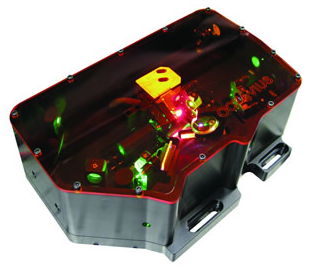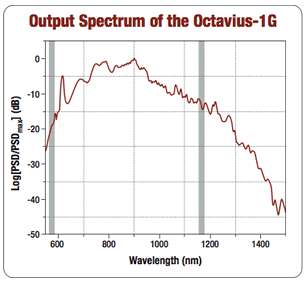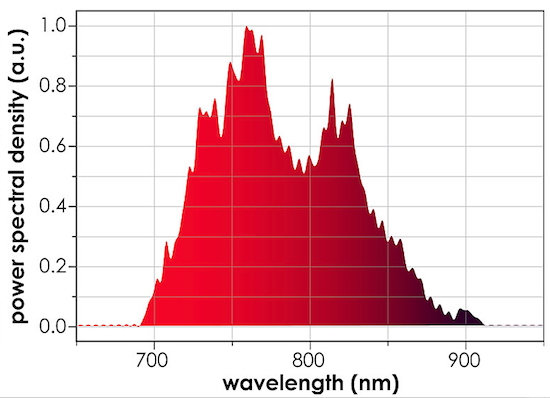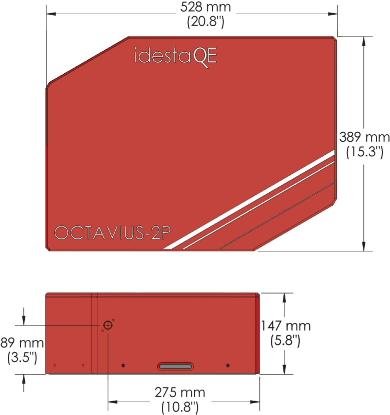Reality check for the Octavius-2P laser

Lasers for 2-photon microscopy are special in that they deliver all of their photons in a short period of time. Take a standard Ti:Sapph with an 80 MHz pulse rate and 100 fs pulses. If each pulse was scaled up to 1 second in duration, then the time between pulses would be about 28 hours. Since the laser is “off” 99.999% of the time, the average power is relatively low, but during a pulse, the probability of a 2-photon event is relatively high. But as discussed earlier, these short pulse durations are paired with large spectral spreads. For 100 fs pulses, the spread is only about 10 nm, but for shorter pulses, it can be considerable. That is the topic of today’s post.
There’s a new Octavius-2P laser that Thorlabs and Idesta are selling. It’s nice to have some variety on the market. The Octavius line offers absurdly short pulse durations. Coherent and Newport Ti:Sapphs offer about 70-110 fs pulse durations, and some of their special products get down to 35 fs. The pulse duration of the Octavius 1G is about 4.9fs FWHM. That gives a spectral spread about 200nm wide (actually, there are significant contributions from 600-1400nm, but most of the heat is in a 200nm band).

The Octavius 2P Thorlabs is selling is a similar offering and has a spectral spread covering about 720-860 nm.


The marketing line is that “this is great because now you can simultaneously excite multiple fluorophores”. The reality check that needs to be made is: Is that necessarily a good thing?
There are some reasons why it might not be. First, there is a lot of autofluorescence at lower wavelengths. If the emission of the autofluorescence is in the same band as the fluorophore of interest, then this laser buys you more background. Second, there is a loss of specificity. For example, some people distiguish Oregon Green BAPTA staining from GFP staining based on excitation wavelength (GFP is much hotter up around 910).
Of course, if you can get bandpass filters to clean up the laser output and confine it to a narrow band, then all of these problems go away. But there is one more consideration that doesn’t: 10 fs pulses are not easy to deal with and require prechirping. Most standard optics, including mirrors in many cases, will cause massive dispersion of 10 fs pulses. Once you add in the cost and hassle of prechirping, plus the filters to clean up the laser output, the Octavius might not be the most attractive option.
With that reality check out of the way, I want to repeat that it’s great to have another 2P laser product on the market and I’m sure this will be just the ticket for many users. I just want to make sure people know that it’s quite a different beast from the usual Ti:Sapph. For some, the differences will be the selling point, for others it’ll be a dealbreaker.
“Of course, if you can get bandpass filters to clean up the laser output and confine it to a narrow band, then all of these problems go away.”
I don’t think that’s right. There’s a bandwith / pulse width tradeoff due to Heisenberg’s uncertainty principle, and if you filter the pulses you’ll inevitably broaden them.
Concerning the price of the pre-chirping: IIRC the pre-chirper Thorlabs is offering in combination with the Octavius has a similar price tag as the laser itself (USD 100K?).
Another problem I see is that the laser power capable of exciting the fluorophore of interest is only part of the total laser power. Taking the square relation between incident light and 2P excitation into consideration, I would expect that to result in significantly higher laser illumination for the same signal strength, resulting in more heating of the tissue and photodamage?
@ddd: About broadening the pulses: you’re right, pulse dispersion is a big issue and will require prechirping. If the clean-up filters are 10-20 nm wide in the passband, then it should be possible to have reasonable pulses (~100fs) at the prep. Of course, this will lower the peak power, and this may be a limiting factor. Since the average power of this laser is about 1/6th of current Ti:Sapphs, any pulse broadening really lowers the power headroom.
@CW: I was just talking to them yesterday. They gave me the prices. They’re aiming to have a soup-to-nuts kit (including laser, prechirper, scope, etc.) for around 200k. So they’re certainly competitive on price, compared to a Ti:Sapph and one of the other kits available.
About photodamage: Thorlabs is keen to do some real world tests. It’s not clear if shorter pulses are better in this case. Between 1000 fs and 100 fs, then of course the latter is better. But it’s not clear if going under 10fs is better still. As I mentioned above, maybe this laser can be used after broadening the pulses to something around 100fs.
At this point, I think some real world tests are needed. With a live prep, A/Bing with a Ti:Sapph, and a spectrophotometer and autocorrelator to monitor the pulses.
I’d like to see what 10fs pulses do to the photobleaching timecourse.
Although not referencing the Octavius laser directly, here are some references that discuss 10fs pulses in 2P microscopy.
Xiaobao Liang, Wenyan Hu, and Ling Fu, “Pulse compression in two-photon excitation fluorescence microscopy,” Opt. Express 18, 14893-14904 (2010)
Rajesh S. Pillai, Caroline Boudoux, Guillaume Labroille, Nicolas Olivier, Israel Veilleux, Emmanuel Farge, Manuel Joffre, and Emmanuel Beaurepaire Multiplexed two-photon microscopy of dynamic biological samples with shaped broadband pulses. Optics Express, Vol. 17, Issue 15, pp. 12741-12752 (2009)
Pang, S., Yeh, A. T., Wang, C. Meissner, K. E. Beyond the 1/Tp limit: two-photon excited fluorescence using pulses as short as sub-10-fs. J. Biomed. Opt. 14, 054041 (2009).
Peng Xi, Yair Andegeko, Dmitry Pestov, Vadim V. Lovozoy, and Marcos Dantus Two-photon imaging using adaptive phase compensated ultrashort laser pulses. J. Biomed. Opt. 14, 014002 (Jan 26, 2009)
Adam M. Larson and Alvin T. Yeh, “Delivery of sub-10-fs pulses for nonlinear optical microscopy by polarization-maintaining single mode optical fiber,” Optics Express 16, 14723-14730 (2008)
Tang, S. Krasieva, T. B., Chen Z., Tempea, G., Tromberg, B. J. Effect of pulse duration on two-photon excited fluorescence and second harmonic generation in nonlinear optical microscopy. J. Biomed. Opt. 11, 020501 (2006).
Larson, A. M. and Yeh, A. T. Ex-Vivo characterization of sub-10-fs pulses. Opt. Lett. 31, 1681–1683 (2006).
[…] It takes about 3 watts of average power in a beam for 150 fs pulses to match the peak power of 50 fs pulses in a beam with an average power of 1 watt. Note that once one gets down to lower pulse widths, dispersion is more pronounced, so shorter isn’t always better. […]